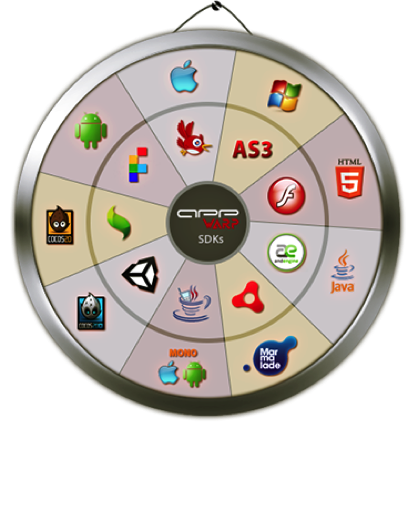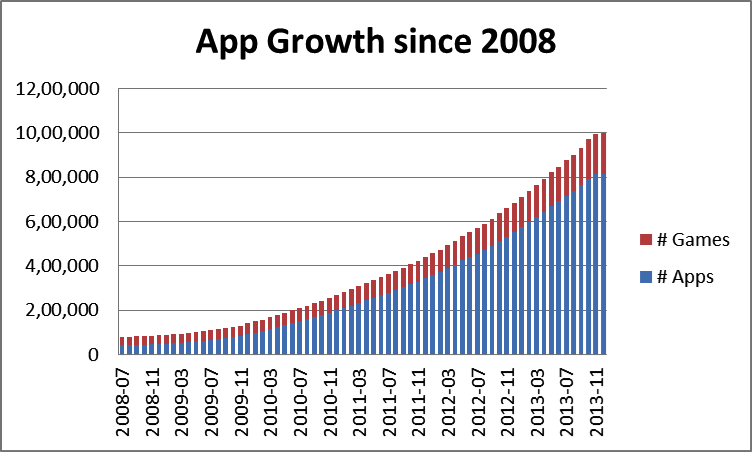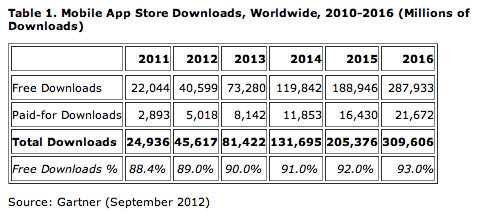ShepHertz endeavour is to make App developers successful on the Cloud, irrespective of the technology or platform on which they are developing. They provide a complete cloud ecosystem for app development – Mobile, Web, Social, Gaming and TV Apps. All their products focus on making App developers’ life easy and augment their business. ShepHertz is founded by Siddhartha Chandurkar who was head of architecture team in Wipro’s Software Products Group before starting ShepHertz in 2010. ShepHertz is already in top3-4 platform providers in its space in the world, and it aims to be #1 over next 12-18 months.
Introduction
I am sure many of you have entertained this thought: this is a nice little idea that I can create an app about. Some of you take this thought a step forward, and try to find an easy way to develop (or get developed) such an app. Then you realize that there is a lot of basic but critical stuff that need to be created – managing user login and profile details, handling communication through emails and notifications, incorporating some social engagement features – before you can truly build your neat little idea. The thought of so much work dissuades you and move on, disappointed a bit, marveling at app developers tenacity a lot, and forgetting your idea for a while.
It doesn’t need to be so. Most apps need lots of these basic services to be built which will not create a differentiated product but it will sink the product if not done well. This is like hygiene factor of the product, crucial for its existence. It would be nice if someone could take over these functionalities and let the app developers focus on real differentiators needed to win the market – neat ideas and awesome user experience.
Enter ShepHertz. If you are a wannabe developer described above, or an individual developer toiling in any part of the world, ShepHertz offers you a suite of back-end services in cloud that allow you to dramatically cut the time you spend building your app. Not only that, since they have a robust infrastructure where these services are hosted, you don’t have to worry about building these services at scale, you just focus on building the experience you want to build.
They have really understood the pain of development; on last count, they had SDK for over 18 platforms and languages, and over 2 dozen services for some of these platforms.
Even though we are talking about individual developer, large app and game development companies and studios are their biggest customers and leverage their platform for faster time-to-market and robust backend services.
Development of app is one part of the story however. For a successful game developer (or a company), development, monetization and distribution are key requirements. Shephertz envisions itself to be a technology agnostic ecosystem provider and offer a wide spectrum of products and tools for App developers.
Sidhhartha says, “ShepHertz endeavour is to make App developers successful on the Cloud, irrespective of the technology or platform on which they are developing. All our products focus on making App developer’s life easy and augment their business.”
The Shephertz Service
ShepHertz provides Complete Cloud Ecosystem for Apps – Mobile, Web, Social, Gaming and TV Apps. To achieve this, they have multiple product lines, catering to different types of developers – right from independent developers, app studios to enterprises.
They offer compelling service to developers:
- Faster time-to-market: Back-end services take time and careful attention to develop. By managing entire back-end, Shephertz dramatically cuts down the development time and cost very significantly for the developers.
- Allow infinite scaling: Since they manage all the infrastructure and scale challenges for the developers, the developer doesn’t need to worry about implications of overnight success (many apps lose shine because they can’t handle success). They can continue doing what they do best – create beautiful and useful apps.
- Pay as you grow plans: Independent developers can start with free plans, paid plans start very low to allow everyone to use it and as they grow, they can buy richer functionalities. This allows them to address all levels of developers.
- In-app analytics: Getting insight into app usage and user behavior is key to monetization and viral distribution. Shephertz provides easy way for the app developers to access the usage data through multiple visualization means and get better understanding and insights.
Offerings
They have many product lines, 2 of the most important ones that we discuss here are their Cloud API (App42 API) Mobile Backend-as-a-service (MBaaS) , App42 PaaS – Platform as a Service and Game development platform (AppWarp). Their AppClay and AppHawk are other platforms that developers can leverage.
Cloud APIs
A Rich set of APIs for multiple platforms and multiple modules in each platform significantly reduces the complexity of developing an app. For an app developer, it is as simple as registering and browsing through the SDK and finding the services that he and leverage, and get coding!
Some of the functionalities for which the APIs exist are:
- User
- Push Notification
- Recommendation
- In-app analytics
- Review/rating
- Many more..
Multiplayer Gaming Network Engine
For game developers, this product takes the complexity of managing the core multi-player interactions away and helps the developers focus on creating engaging games. Multiplayer gaming engine, protocol for message exchange, room/lobby logic, etc. require lots of efforts to build and are a must for any game. Some of the features of this product are:
- Connection Resiliency
- Room Properties
- Match-making
- Many more..
Differentiators
Some things stand out as differentiators:
- Eco-system approach: They are an eco-system provider, unlike other other competitors who offer one piece of the puzzle and the developer has to work with multiple vendors to get a complete solution
- Technology and Access channel agnostic – They have support almost all popular platforms and technologies through their native SDKs
- Comprehensiveness: They have a very large number of APIs and services, much more than their competition. This allows them to attract different types of developers because they can cater to all.
- Large Developer Traffic: They have one of the highest Alexa ranking in the industry, and it has been steadily getting better (Global: 32,214, India: 1656).
Development Process
Working with multiple product lines for a startup can be very challenging. Their teams are aligned based on Products. Each product is owned by one of the Product Owners. The Product owner is responsible for all the activities with respect to the product – Technology, Support, Team management, Blogs etc. Common functions like graphics, digital marketing team, etc. are shared by the Product Owners coordinated by the Marketing head.
Development team works using Agile development process which allow them to come up with robust features in a very short time. Instead of documents, they discuss things on whiteboard and take pictures and save the images for record. They have regular vision definition and alignment meetings to discuss strategic issues so that the adhoc meetings have direction and purpose.
It is very tempting for a startup to listen too much to a single early client and end up building products that are too specific and don’t address the market. It is important to keep the balance, and Shephertz has done it well. Siddhartha says, “The germination of any product happens with the combination of two things :- The founders vision on a perceived need which does not exist in the market i.e. the customer does not even know that he has a need and secondly from market research, customer feedback and competition. We have come up with the product line based on what we thought does not exist and later fined tuned it with customer feedback.”
Market
Size
Number of apps are growing steadily and rapidly over last 4-5 years. For example, see the trend on iTunes App Store
Data Source: 148apps.biz
Marketing
Shephertz is in a good position to tap into this growth. Now that their product lines are fairly complete, their focus is 2-fold:
- Handling growth as developers come on the platform
- Manage local offices in different countries to tap into local developer eco-system
They are already growing at tremendous speed, and their target is to grow 20X over next 12 months.
Most of their marketing is content marketing – they spend lots of effort in writing in detail about their SDKs, its usage, sample code and examples – essentially lots of supporting content to help developers use their platform effectively and quickly. This has helped them attract a large developer crowd, and build their brand. They also Blog in multiple languages in order to reach and support local developers. There are thousands of apps live that use their libraries and the number is steadily going up.
They also need to deal with the issues of being a hard-core tech company that is based in India and not in US:
- Branding and Credibility – Made in India brand is still not catchy enough world-wide and so they need to struggle extra-hard to build a credibility of the brand world-wide. This problem is largely solved now with many big customers vouching for them.
- Lack of eco-system proximity – Developer eco-system is much larger in US than in India, and most of the action is there. It also becomes hard to attract investment and attention.
Competition
Hot segments bring in hot competition. Since they have multiple product lines, they have different competitors for different lines. Parse (acquired by Facebook), Kinvey, Photon and Heroku are some of their competitors or different lines. With Rackspace, Salesforce.com, Amazon, and Google all making a play for this space, competition is really hot and getting hotter in this space. However, given the fact that their product is fairly complete at this point, they are ahead of most of their competitors.
The Road Ahead
There are 3.2 million developers out there and about 2 million apps currently and steadily going up. Given the way web is going mobile, this is a market that is on a steep upward trend. By being the back-end provider for the app and games in a platform and technology agnostic manner, Shephertz can be a game-changer for the industry. With the comprehensive offering, end-to-end solutions approach, and push to be present in all geographies where developers are present, Shephertz is on a good growth path. It is already in top 3-4 game backend provider category.
They do need to simplify their marketing message on their website and otherwise to be less techie and more business-focused so that the value is readily apparent to even a casual visitor to their site – currently it is too technology focused.
This is one of the few technology and platform companies from India with a potential to be a billion dollar one and we wish them good luck!








